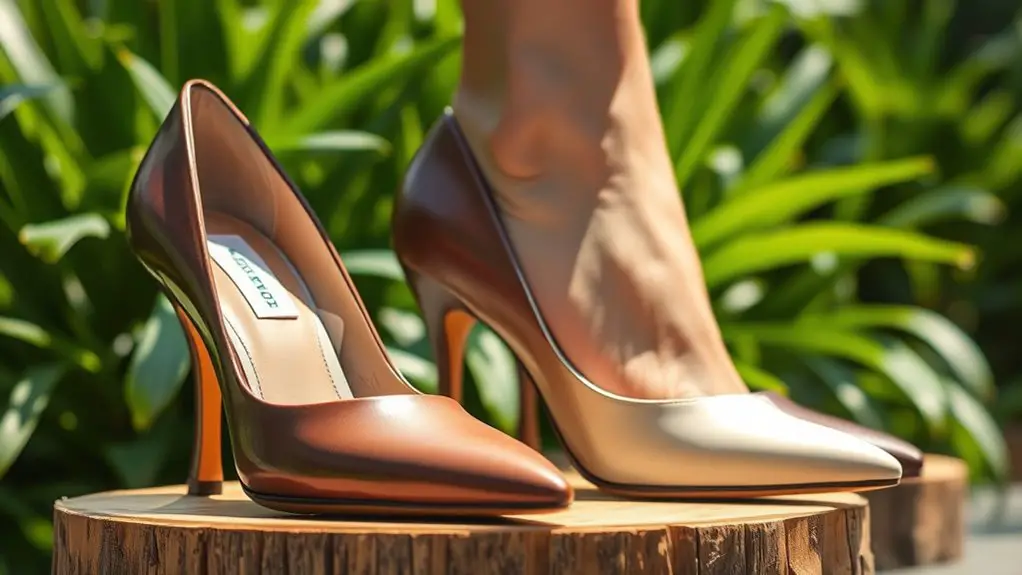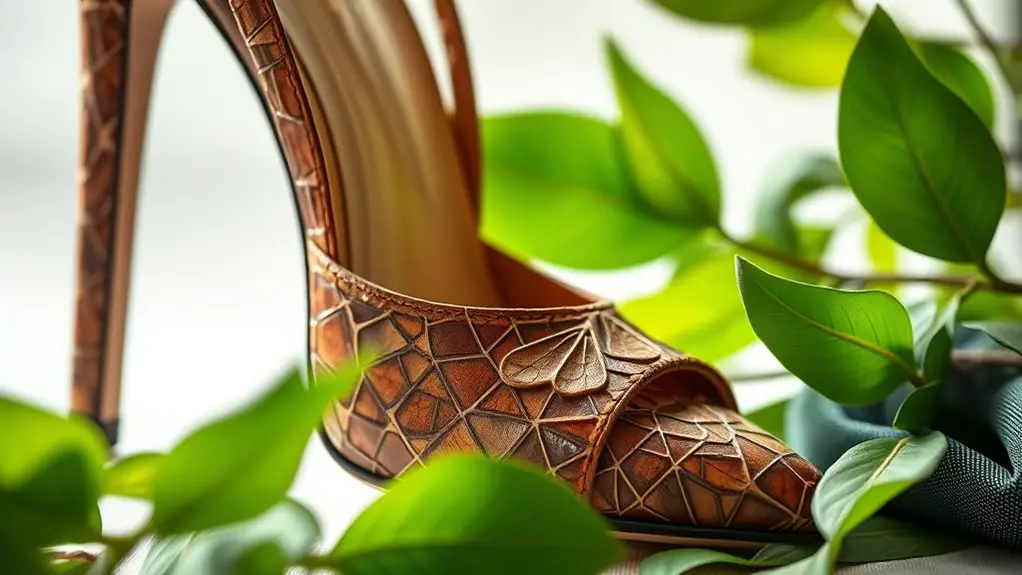Sustainable materials are transforming heel manufacturing by prioritizing eco-friendliness, reducing waste, and promoting ethical practices. Biodegradable options, recycled components, and innovative designs are not just fashionable; they also lower carbon footprints and reliance on virgin materials. As brands respond to consumer demand for transparency and responsibility, the future of heel design looks promising. You’ll find that understanding these changes reveals even more exciting developments in sustainable fashion.
The Rise of Sustainable Footwear

As consumers increasingly prioritize eco-friendliness, the rise of sustainable footwear has transformed the industry landscape. You’re likely noticing brands adopting practices centered around ethical sourcing, ensuring materials are obtained responsibly and supporting fair labor practices. This shift not only reflects consumer values but also drives innovation in design and production.
The concept of a circular economy is becoming integral to footwear manufacturing; companies are rethinking their processes to minimize waste and extend product life cycles. You might find brands offering take-back programs, where old shoes are recycled into new products, reducing the environmental footprint.
Innovative Materials in Heel Production
As you explore the future of heel production, you’ll find that innovative materials are changing the game. Biodegradable options and the utilization of recycled materials not only enhance sustainability but also push the boundaries of design and performance. This shift towards eco-friendly materials presents exciting opportunities for both manufacturers and consumers alike.
Biodegradable Heel Options
While the footwear industry has long relied on synthetic materials for heel production, a growing demand for sustainability has sparked innovation in biodegradable options. You’ll find that biodegradable polymers, such as polylactic acid (PLA) and polyhydroxyalkanoates (PHA), are leading the charge. These materials not only reduce environmental impact but also offer comparable performance to traditional materials. Combined with eco-friendly adhesives, they create a robust solution for sustainable heel manufacturing.
| Material Type | Benefits | Applications |
|---|---|---|
| PLA | Compostable, lightweight | Casual and athletic shoes |
| PHA | Biodegradable, durable | Fashion and formal heels |
| Natural Rubber | Flexible, renewable | Work and outdoor footwear |
| Cork | Lightweight, shock-absorbent | Comfort and casual shoes |
| Hemp | Strong, sustainable | High-fashion heels |
Recycled Materials Utilization
Incorporating recycled materials into heel production not only addresses sustainability concerns but also opens doors to innovative design possibilities. By utilizing recycled polymers, you can create heels that are both stylish and environmentally friendly. This approach not only reduces waste but also emphasizes sustainable sourcing, ensuring that materials are responsibly obtained.
Consider the following benefits of recycled materials in heel manufacturing:
- Reduced environmental impact: Less waste in landfills and lower carbon footprint.
- Cost-effectiveness: Often cheaper than virgin materials, promoting affordability.
- Enhanced creativity: Unique textures and colors arise from diverse recycled sources.
- Market differentiation: Stand out in a competitive landscape by showcasing eco-conscious designs.
Embracing recycled materials can transform your production process and appeal to the growing eco-aware consumer base.
The Role of Recycled Components

Recycled components can greatly reduce the environmental impact of heel manufacturing by minimizing waste and lowering resource consumption. By exploring innovative material sources, you’re not just enhancing sustainability but also unleashing potential for unique designs. This shift opens up exciting possibilities for the future of fashion without sacrificing style or performance.
Environmental Impact Reduction
As the fashion industry increasingly prioritizes sustainability, the integration of recycled components in heel manufacturing emerges as a pivotal strategy for reducing environmental impact. By utilizing materials like recycled plastics and rubber, brands can markedly lower carbon emissions while promoting resource conservation. This approach not only minimizes waste but also encourages a circular economy within the industry.
- Reduces reliance on virgin materials
- Decreases landfill waste
- Lowers carbon footprint during production
- Supports eco-friendly consumer choices
Innovative Material Sources
The emergence of innovative material sources is transforming heel manufacturing, shifting the focus towards sustainable practices that harness recycled components. You’ll find that alternative fibers, such as bamboo and hemp, are gaining traction in heel production. These materials not only reduce waste but also offer unique aesthetic qualities. By integrating natural adhesives, manufacturers enhance the durability and eco-friendliness of their products, minimizing harmful chemicals usually found in traditional bonding agents. As you explore these advancements, it’s clear that sustainability and functionality can coexist, leading to a new era of footwear design. Embracing these recycled components not only champions environmental responsibility but also encourages creativity and innovation in heel manufacturing, making it a win-win for consumers and the planet alike.
Bio-Based Plastics: A Game Changer
While traditional plastics have dominated the footwear industry for decades, bio-based plastics are emerging as a revolutionary alternative that addresses sustainability concerns. These materials are derived from renewable resources, making them a promising eco-friendly alternative. As you explore the concept of bio-based plastics, you’ll discover several bio-based benefits that can transform heel manufacturing.
- Reduced reliance on fossil fuels
- Lower carbon emissions during production
- Enhanced biodegradability
- Improved consumer perception of sustainability
Reducing Carbon Footprint in Manufacturing

With the rise of bio-based plastics in heel manufacturing, manufacturers are now more motivated than ever to minimize their carbon footprints. By adopting energy efficient processes, they not only reduce emissions during production but also cut operational costs. Utilizing renewable energy sources, like solar and wind, has become a common practice, allowing companies to power their facilities sustainably.
Incorporating carbon offsetting strategies is another effective approach. Manufacturers can invest in reforestation projects or renewable energy initiatives to counterbalance emissions generated during the manufacturing process. This holistic approach not only enhances brand reputation but also appeals to environmentally conscious consumers.
Furthermore, optimizing supply chains through local sourcing can greatly decrease transportation emissions, further contributing to a lower carbon footprint. By embracing these innovative practices, heel manufacturers are leading the charge toward a more sustainable future, proving that eco-responsibility and profitability can go hand in hand.
Consumer Demand for Eco-Friendly Options
As consumers increasingly prioritize sustainability in their purchasing decisions, the demand for eco-friendly options in heel manufacturing is surging. Eco-conscious shoppers are reshaping consumer preferences, pushing brands to innovate with sustainable materials. This shift reflects a broader trend where ethical choices are becoming essential for market competitiveness.
Here are some key factors driving this demand:
- Transparency: Shoppers want to know the sourcing and production methods behind their heels.
- Quality: Eco-friendly materials often offer comparable durability and style as traditional options.
- Social Responsibility: Brands focusing on sustainability attract a loyal customer base that values ethical practices.
- Aesthetic Appeal: Innovative designs using sustainable materials can make eco-friendly heels just as fashionable.
With these preferences in mind, heel manufacturers are evolving to meet the rising expectations of environmentally aware consumers. The future of heel design will certainly reflect this growing commitment to sustainability.
The Future of Sustainable Heel Design
The rising consumer demand for eco-friendly options is shaping the future of sustainable heel design in exciting ways. You’ll likely see an increasing integration of futuristic aesthetics, where sleek lines and innovative materials redefine what heels can look like. Designers are tapping into bioplastics and recycled materials, creating shoes that not only reduce waste but also captivate with their modern appeal.
Moreover, ethical craftsmanship is becoming a core principle. Brands are prioritizing transparency in their supply chains, ensuring that each heel is produced responsibly. You might notice a shift toward local artisanship, where skilled craftspeople create limited runs, adding a unique touch to each pair. This commitment to sustainability doesn’t just appeal to your values; it also elevates the overall design experience. As you choose your next pair of heels, you’ll find that style and sustainability can beautifully coexist, paving the way for a more responsible fashion future.
Frequently Asked Questions
How Do Sustainable Heels Compare in Price to Traditional Heels?
When you do a cost analysis, sustainable heels often have a higher upfront price compared to traditional options. However, a price comparison over time reveals potential savings through durability and lower environmental impact, making them worthwhile.
Are There Specific Brands Leading the Sustainable Heel Movement?
You’ll find several brands leading the charge in sustainable heels, combining ethical production with eco-friendly innovations. While traditional options may seem glamorous, these pioneers prove that sustainability can be stylish, too.
Can Sustainable Heels Be Stylish and Fashionable?
Absolutely, sustainable heels can be stylish and fashionable. With eco-friendly designs and trendy materials, you can enjoy chic footwear that aligns with your values, proving that style and sustainability can go hand in hand seamlessly.
What Are the Maintenance Requirements for Sustainable Heels?
You might think sustainable heels require more effort, but they don’t! For eco-friendly care, clean them gently and store in a cool place. Follow longevity tips, and they’ll stay stylish and durable for years.
How Can Consumers Identify Genuinely Sustainable Footwear Brands?
To identify genuinely sustainable footwear brands, look for certification labels and research their use of eco-friendly materials. Brands committed to sustainability often highlight these aspects, ensuring you make informed choices for your footwear purchases.



